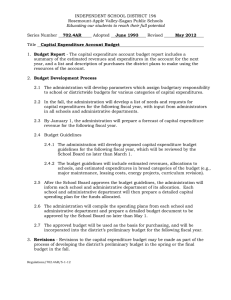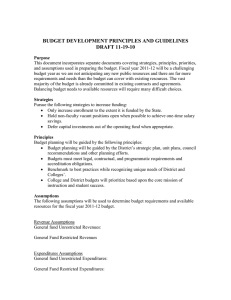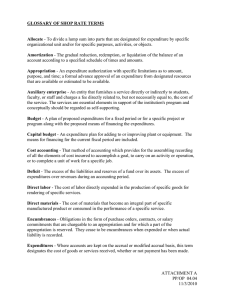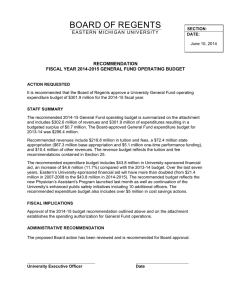Turkish Economy Fiscal Policies:Taxation & Budget Expenditure
advertisement
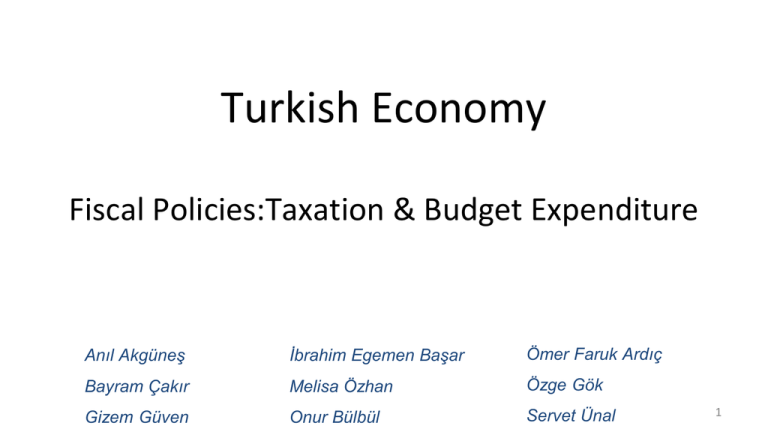
Turkish Economy Fiscal Policies:Taxation & Budget Expenditure Anıl Akgüneş İbrahim Egemen Başar Ömer Faruk Ardıç Bayram Çakır Melisa Özhan Özge Gök Gizem Güven Onur Bülbül Servet Ünal 1 Fiscal Policies: Taxation & Budget Expenditure 1923 - 1945 2 1923-1938 Fiscal Policy: In this period there has been three major factors that led the fiscal policy: • Fundamental fiscal problems originating from Ottoman Empire • Fiscal provisions of the Lozan Agreement • Fiscal decisions in Izmir Economy Congress 1923-1929 Budget Policy: • • • Balanced Saving-oriented Expenditures financed by taxes 3 1923 - 1929 Tax Policy and Applications In this period, taxes on income: • Aşar –Tax on agricultural products in Ottoman Empire –In Izmir Economy Congress, it was removed from application • Temettü (Dividend) –Tax on the income of the tradesman and the craftsman in Ottoman Empire • Kazanç (Profit) –Instead of “Temettü(dividend) Tax”, in 1926, “Profit Tax” was adopted. Profit Tax; • Filling the income gap arising from the abolition of Asar • More suitable for modern taxation 4 5 1930 - 1938 Fiscal Policy: In 1930-38 period, there were two elements dominating the economic and fiscal policy: • Protectionism – Tariffs on imported goods, restrictive quotas, and a variety of other government regulations • Etatism – State intervention, state-led industrilization, state enterprizes 6 Tax Regulations Between 1930 - 1938: • 1931 Economic Depression Tax • 1932 Equalisation Tax • 1936 Tax for airforces 7 1939 - 1945 War Period: Factors that affect public expenditures: • Second World War • Prevalent security expenditures • Constant price increases lead to increase in employer expenditures so prevalent expenditures increase too 8 1939 - 1945: 9 1939 - 1945: Saracoglu government’s defence mechanism against inflation and excessive profit on black market includes two extraordinary taxes : • Wealth Tax • Tax on Agricultural Product 10 Tax on agricultural products in 1941: • The main aim of the tax is to cover expenses of army. • It was implemented on only some agricultural products. • It was generated in cash or in kind depending on the products • In terms of liabilities of the agricultural product tax, it was perceived as returning of the Aşar tax so it had some reactions. 11 Wealth Tax in 1942: • It was considered as extraordinary tax on wealth. • It was implemented because of two reasons which were slowing down inflation and taxing the extraordinary profits on black market The results; • The tax revenue was lower than expected. • Also it couldn’t be succesful in slowing down inflation 12 Kaynak: Ekonomik Kalkınmanın Vergi Yapısı Üzerindeki Etkisi: 1924-2013 Dönemi Türkiye Örneği, Mehmet Cural - Nüket Kırcı Çevik 13 Public Expenditures: In this period, rate of increase of public expenditures were far behind the price increase. This leads recession in real public expenditures. 14 Government Debts: Internal Debts: • For the expenses of national defence causing from precautions against the war, 150 million Turkish lira was borrowed by government from domestic markets External Debts: • In 1939, 264 million francs was borrowed from France for armament . • In 1942, 100 million mark was borrowed from Germany for supply of military equipment • In 1945 the debts increased by %266 compared to debts in 1939. However gold and foreign exchange reserve were quite close to long term total external debts. 15 1946 - 1953 Opening The Economy: ● 1946 - Turning point of economy into less taxes on imports, foreign debt, foreign capital, agriculture and construction ● Reason: Populist policies due to multi-party regime Pressure of capitalist class ● Boratav: 1946-53 period leads to a continuous external dependency in economy. Although the harmful policies were discarded right after the period, their effects persisted. 16 Tax reforms: • • 1950 reform: – Transition to Income and Corporate Tax regime – A United Tax System – Expansion through including real estate taxes and total income of each household. Reasons; – External debts – Investments for development after the war period – To afford government basic expenditure – Social justice through more equality 17 Source: Ramazan Taş - 1995 18 1954 - 1961 Closing the Economy and Expanding Domestic Investments: • More control on imports and exports by 1954 International Trade regime • Less trade imbalances with less growth rates • Ongoing budget deficit due to high government expenditure and not enough tax revenue • Going towards industrialization rather than agricultural production, which led to more tax revenue from industry 19 Tax Reforms: • More tax burden on all classes • Proportional tax regime in income taxes • Private car tax was introduced in 1959 • Increase in real estate tax rates in 1961 • Tax Reform Committee in 1961 due high tax burden • Investment reduction and tax payment agreements after tax reform comittee 20 Source: Ramazan Taş - 1995 21 1960 - 1980 Era of Development • In this period, fiscal policy is a very important Planning: tool for the Turkish Economy. Governments financed budget deficits via the funds supplied by the Central Bank until the 80s, thus monetary policy is in the secondary place compared to the fiscal policy. 22 • • 1960 - 1980 Era of Development Public Income Policy of Development Plans: Planning: Two Main Targets: – Increase tax income to meet planned increase in public spending. – Transform the taxing system to one that encourages saving and investments. To be specific: – Increase income elasticity of direct taxes. – Industry specific tax rates. – Accelerated depreciation system. – Higher tax rates for luxury goods. – Tax-returns for exports. – Higher tax rates for speculation gains (like real estate) etc. 23 1960 - 1980 Public Income Policy: – The planned vs. realized distribution of Tax Income according to the Tax Types. (% of the Total Tax Income) 24 1960 - 1980 Public Income Policy: – The shares of direct and indirect taxes in the total Tax Income.(% of the Total Tax Income) Source: Bütçe ve Mali Kontrol Genel Müdürlüğü http://www.bumko.gov.tr/TR,4461/butce-gider-gelir-gerceklesmeleri-1924-2012.html 25 1960 - 1980 Public Income Policy: –Predicted vs Realized Tax Income (% of GDP) Source: Bütçe ve Mali Kontrol Genel Müdürlüğü http://www.bumko.gov.tr/TR,4461/butce-gider-gelir-gerceklesmeleri-1924-2012.html 26 1960 - 1980 Public Income Policy: – Predicted vs Realized share of Tax Income in Total Income Source: Bütçe ve Mali Kontrol Genel Müdürlüğü http://www.bumko.gov.tr/TR,4461/butce-gider-gelir-gerceklesmeleri-1924-2012.html 27 1960 - 1980 Public Income Policy: • Possible Explanations for Unsuccessful Implementations: – Political unwillingness to perform structural tax reforms and proper tax auditing. – Failure to equally distribute taxes as aimed in the plans. – Failure to implement local administrations reform and lack of resources of these administrations. – Failure to make necessary legislations needed for efficient operations of SEEs. 28 1960 - 1980 Public Expense Policy: Quick Overlook: – Although the inflation rate was low in the first half of the 60s, towards the end of the decade prices started to rise rapidly. This created a pressure on the budget expenditures. As public income failed to meet the overall expenditures, government tried to cut down current spending. However, since cutting down on public services such as health, military and education is limited to an extend, government’s hand was forced to cut down on investment spending too. 29 1960 - 1980 Public Expense Policy: – Percentage shares of different categories in Total Spending: Source: Bütçe ve Mali Kontrol Genel Müdürlüğü http://www.bumko.gov.tr/TR,4461/butce-gider-gelir-gerceklesmeleri-1924-2012.html 30 1960-1980 Public Expense Policy: – Predicted vs Realized Total Spending (as % of GDP): Source: Bütçe ve Mali Kontrol Genel Müdürlüğü http://www.bumko.gov.tr/TR,4461/butce-gider-gelir-gerceklesmeleri-1924-2012.html 31 1960 - 1980 Deficit Levels: – Predicted vs Realized Budget Balance (as % of GDP): Source: Bütçe ve Mali Kontrol Genel Müdürlüğü http://www.bumko.gov.tr/TR,4461/butce-gider-gelir-gerceklesmeleri-1924-2012.html 32 Till 1980s: • • • • protective policy in foreign trade foreign exchange rate based on fixed rate charging negative interest rate price control mechanism In 80s, more liberal behaviors in world economy 24 January 1980 Stabilization Program; start of an important change Transition from etatist perspective to free market economy 1989 - International financial capital introduced Uncontrolled capital movements was the main factor of Turkey’s instability problem 33 In 1980s: ●Minimizing public consumption ●Preventing wastage ●Minimizing the rate of public hiring ●Nevertheless, public consumption had an increasing pattern Political mobility ○changes in economical and political methods Saving Lack of Public Decline in New Instability Investment Consumption Investments ○changes inConfidence administrative structure Competition ○budget policies After 1986: 34 1980-1990 Public Expenditures (Billion TL) 35 1980-1990: Taxation Tax Policy: • • • • • • • • Diminishing the purchasing power Restricting the domestic demand Lowering the domestic production costs Increasing the prices of KİT (SEE) products Quoting lower prices to agricultural products Restricting the increase in wages Import became more expensive High inflation periods http://www.vergi.tc/makaleDetay/SizdenGelenler/-TURKIYE’DE-1980-SONRASI-UYGULANAN-VERGIPOLITIKALARI-ve-GELIR-DAGILIMI-UZERINDEKI-ETKISI-I/90d5a558-d926-4720-a441-a3e9523b5f9e 36 January 24th, 1980: • New distribution of income → effective tax burden • 1984 and after, tax revenues were decreased After 1980, private sector’s investment increased. In order to decrease the capital owners’ tax burden, there were some practises: • Reducing the tax burden of capital owners’ → Increasing the savings → Minimizing the wealth tax • “Nereden Buldun Yasası” was disabled. • “Decleration of Wealth” law was abolished. • 1985 - KDV • Decreasing the share of direct taxes over total tax revenue & increasing the share of indirect taxes • Stopaj sistemi was became widespread. 37 38 Turkey in 1990s: • different public finance policies compared to 1980s • terrorist incidents • economic crises Turkish Economy in 1990s: • unsustainable internal debt 39 Problems: • Turkish economy was too fragile in 1990s. • Institutions in public sector had a destroyed financial system. • Gulf War and the elections increased public expenditures. • Both 1994 economic crisis and 1999 Marmara earthquake affected puclic expenditures, significantly . 40 After the crisis of 1994; • Budget deficit had increased and then the government started to borrow in order to finance this gap. This led to excessive debt which caused the real interest rate to increase. • Public deficit → debt → high interest rate • This cycle started to feed into itself. • One of the main reason for the increase in the budget expenditure was a rise in the interest 41 42 2000 - 2015: • • • 21st century started with high inflation and economic inconsistency. Government could not solve the budget deficit problem. Banking sector was at the verge of collapse. Results in Numeric Terms: • In November 2000, overnight interest rate raised to 200% due to liquidity problem. • On 1st of December, overnight repo interest increased to 1700%. Istanbul Stock Exchange went down to its yearly lowest value. • At the end of the 2000, Turkey was facing plenty of economic problems. 43 Tax Structure: Compared with the OECD average; ● Higher revenues from taxes on goods and services and social security contribution. ● A lower proportion of revenues from taxes on personal income, corporate income and property. ● No revenues from payroll taxes. Source: oecd.org 44 http://www.bumko.gov.tr/TR,4461/butce-gider-gelir-gerceklesmeleri-1924-2012.html 45 Source: Bütçe ve Mali Kontrol Genel Müdürlüğü http://www.bumko.gov.tr/TR,4461/butce-gider-gelir-gerceklesmeleri-1924-2012.html 46 The amount of the government expenditure was increased continuously during this period. Particularly in the first years of millennium increase is quite sharp. 47 Effects of Fiscal Policies: • Percentage of public expenditure in the GNP was pretty high until 2003 yet it decreased to an acceptable level with tight fiscal policies and considerable increase in GNP. • After the ratio of GE/GNP reached to 46% the government signed a stand by negotiation with IMF. • After decreased interest payments and tight fiscal policies ratio went down by 4.4 percent. 48 Performance of the Policies During Great Recession: • • • • • Structural reforms and fiscal policies showed their positive influences in 2005 and in 2006 the ratio went down to 30%. During the great recession expenditures lost its well going performance and it was increased 15 percent in 2009 yet data indicates that economy recovered in 2010. In 2011, interest payments decreased sharply with low interest rates in the world. On the other hand with the increased tax revenues, total expenditure got 24% of the GNP. Although there were fluctuations between 23 and 28 percent due to financial crisis Turkish economy gave a satisfactory performance during great recession. Decreased interest rate brought out less interest burden therefore budget control became easier. The keyword was ‘’discipline’’ for the Turkish fiscal policies during 2008 crisis. 49 As a conclusion; In an economy, the structure of components of public expenditure and the amount of public expenditure give us important information about how the economy progresses. After the beginning of 1980s, the government in Turkey made a decision to reduce the scale of public expenditure in the GDP because of neo-liberal policy. • in the beginning of 1980s, this ratio was 20%. • in the middle of 1980s, the ratio was reduced to 15%. • in 2001, the ratio was 45%. • in recent years, the ratio is 25% with the political stability and the regulation of fiscal dicipline. 50 References: • • • • • • Marmara Üniversitesi, İ.İ.B.F. Dergisi ,YIL 2009, CİLT XXVII, SAYI II, S. 297-328 - TÜRKİYE’DE 1923-1938 DÖNEMİ MALİYE POLİTİKASI UYGULAMALARI - Doç.Dr. Gülay AKGÜL YILMAZ* http://dosya.marmara.edu.tr/ikf/iib-dergi/2009-2/akgul.yilmaz.pdf http://www.vergi.tc/makaleDetay/SizdenGelenler/-TURKIYE’DE-1980-SONRASI-UYGULANAN-VERGI-POLITIKALARI-ve-GELIR-DAGILIMIUZERINDEKI-ETKISI-I/90d5a558-d926-4720-a441-a3e9523b5f9e http://dergiler.ankara.edu.tr/dergiler/42/468/5415.pdf http://dergipark.ulakbim.gov.tr/anemon/article/view/5000119764 Ekonomik Kalkınmanın Vergi Yapısı Üzerindeki Etkisi: 1924-2013 Dönemi Türkiye Örneği, Mehmet Cural - Nüket Kırcı Çevikhttp://www.todaie.edu.tr/resimler/ekler/37a3846dffafaa7_ek.pdf?dergi=Amme%20Idaresi%20Dergisi TAKIM, A. (2011, Ocak-Haziran). Türkiye’de 1960-1980 Yılları Arasında Uygulanan Kalkınma Planlarında Maliye Politikaları. Maliye Dergisi, pp. 154-176. 51 52
